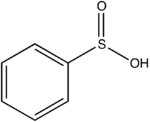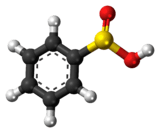Phenylsulfinic acid
 | |
 | |
| Names | |
|---|---|
| Other names
phenyl sulfinic acid, benzene sulfinic acid, benzenesulfinic acid | |
| Identifiers | |
3D model (JSmol) |
|
| ChemSpider | |
| ECHA InfoCard | 100.009.591 |
PubChem CID |
|
| |
| |
| Properties | |
| C6H6O2S | |
| Molar mass | 142.17 g·mol−1 |
| Appearance | Colorless prisms |
| Density | 1.45 g/cm3 |
| Melting point | 83 to 84 °C (181 to 183 °F; 356 to 357 K) |
| Acidity (pKa) | 2.76 |
Except where otherwise noted, data are given for materials in their standard state (at 25 °C [77 °F], 100 kPa). | |
| Infobox references | |
Phenylsulfinic acid is an organosulfur compound with the formula C6H5SO2H. It is a colorless or white crystalline solid that is usually stored in the form of its sodium salt. In aqueous solution it is strongly acidic and is easily oxidized in air. Phenylsulfinic acid and its esters are chiral.
Acidity
Although many sources report the pKa value as somewhere around 1.30,[1][2][3] these results are inconsistent. However, a reproducible method was developed by Filippo et al. in which the pKa was determined to be 2.764.[4] This is a strong acid compared to its corresponding carboxylic acid, benzoic acid (pKa = 4.2), but weak when compared to its corresponding sulfonic acid (pKa = -6.5).[5]
Preparation
Phenylsulfinic acid can be prepared in several ways, most easily through reduction of sulfonyl chlorides with zinc dust or iron.[1] However other starting materials can be used. Due to the air sensitivity of this compound it is often formed as a salt.
- 2 C6H5SO2Cl + 2 Zn → (C6H5SO2)2Zn +ZnCl2
- (C6H5SO2)2Zn + Na2CO3 +NaOH → 2 C6H5SO2Na + ZnCO3
A convenient method is the reduction of the sulfonyl chloride or sulfonyl fluoride with sodium sulfite, producing the acid instead of a salt:[2]
- C6H5SO2Cl + Na2SO3 + H2O → C6H5SO2H + NaCl + NaHSO4
Many other methods have been reported for production of sulfinic acids such as the use tin(II) chloride, or the Grignard reagent with sulfur dioxide.[3] The preparation of sulfinic acids by the oxidation of thiols is difficult due to overoxidation.
Properties
In sulfinic acids, sulfur has the +4 oxidation state. They are prone to oxidation to sulphonic acids as well as reduction via sulphenic acids (+2) to thiols.[1]
Sulphinic acid derivatives disproportionate in the presence of acid:[1]
- 2 PhSO2H → PhSO2SOPh + H2O
- PhSO2SOPh → PhSO2• + PhSO → PhSO3SPh
- PhSO3SPh + PhSO2H → PhSO3H + PhSO2SPh
When phenylsulfinic acid reacts with sulfur to give thiosulfinates and thiosulfinic acids.[6]
Use
The main use of phenylsulfinic acid is for the asymmetric synthesis of carbon-carbon bonds due to its ability to stabilize negative charges on an adjacent carbon atom. Phenylsulfinic acid has been a component for electroplating of palladium alloys.[7]
References
- 1 2 3 4 S. Patiai (1990). The Chemistry of Sulphinic Acids, Esters and Their Derivatives. New York: J. Wiley and Sons. ISBN 0-471-91918-7.
- 1 2 a) A. T. Fuller, I. M. Tonkin and J. Walker, J. Chem. Soc., 1945, 636; b) S. Smiles and C. M. Bere, "Organic Syntheses," Coll. Vol. I, ed. by A. H. Blatt, John Wiley and Sons, Inc., New York, 1948, p. 7; c) E. Bader and H. D. Hermann, Chem. Ber., 88, 46 (1955); d) M. Kulka, Can. J. Chem., 32, 601 (1954).
- 1 2 R. J. Cremlyn (1996). An Introduction to Organosulfur Chemistry. New York: J. Wiley and Sons. ISBN 0-471-95512-4.
- ↑ De Filippo, D.; Momicchioli, F. (1969). "A study of benzenesulfinic and seleninic acids". Tetrahedron. 25 (23): 5733. doi:10.1016/S0040-4020(01)83080-5.
- ↑ E. P. Serjeant, B. Dempsey. "Ionization Constants of Organic Acids in Solution" IUPAC Data, Series No. 23 (Pergamon Press, Oxford)
- ↑ B. Zwanenburg; A.J. H. Klunder (1987). Perspectives in the Organic Chemistry of Sulfur. New York: Elsevier. ISBN 0-444-42739-2.
- ↑ Chiang, Yunn Hui; Luloff, Jerome S.; Schipper, Edgar (1969). "Aminolyses of sulfinic acid derivatives". The Journal of Organic Chemistry. 34 (8): 2397. doi:10.1021/jo01260a031.